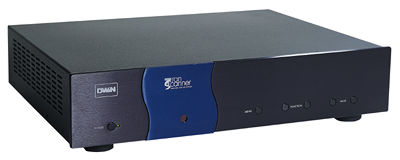Dwin HD-700 video projector Page 2

The generic remote that Dwin provides with the HD-700 is factory-programmed for use with the Dwin projector and TranScanner, and is more versatile than the remote Dwin has used in the past. Because it's not specifically designed for use with the HD-700, the new remote is more complex than it needs to be, but that gives it the flexibility needed not just for use with the Dwins, but with other components in your system as well.
Performance
I'd put in extensive time watching the Dwin HDP-500, so I wasn't really surprised by the images from the new HD-700. But after experiencing great performance from such behemoths as the big Vidikron, Sony, and Runco 9-inch CRT projectors, it's still amazing to get such satisfying results from a relatively pint-sized package. The HD-700 didn't leave a lot to be desired. With its rich color, crisp image, and low noise (video and mechanical), there was little to criticize. The picture "popped." The light output was never a concern on my 78-inch-wide, 1.3-gain screen. I've also seen the HD-700 used with larger screens, and its light output was adequate as long as the screen wasn't crazy big. I don't recommend a screen width much beyond 84 inches, however, with any projector using 7-inch tubes.
But with proper setup of its user video controls, the clarity and crispness of the Dwin's picture were hard to fault. (In particular, I increased the Sharpness controls on the Pioneer Elite DV-09 DVD player from full off with the Vidikron to just below midpoint with the Dwin.) Stuart Little is an amazing transfer, one of the best of the year. The Dwin made the most of its rich, brilliant, even slightly overdone colors. Blacks were rich and deep, with plenty of shadow detail. The image looked nearly 3-dimensional—a characteristic of the best video displays. 
The biggest difference between the Dwin and larger, more expensive projectors was in sharpness. It was no surprise that I didn't find the Dwin's resolution equivalent to the twice-as-expensive Vidikron Vision Three's, but saying so risks giving the wrong impression. In fact, on a screen of reasonable size with a good DVD, I was aware of no softness in the Dwin's image. In Shakespeare in Love—one of the best DVDs around—I was aware of loss of detail only in the costumes, for example, or in the medium shot of the dog in chapter 16, and even then, only because I have seen these images many times on state-of-the-art CRTs. The Dwin's overall performance was so balanced, with no serious weaknesses, that such criticisms seem petty.
In fact, while I was unable to compare the HD-700 side-by-side with the HDP-500, my impression was that the new projector was sharper. The new transfer of Lethal Weapon isn't perfect (the softness of some medium and long shots may well be in the original photography), but the close-ups are stunningly clear, with fine color balance and accurate flesh tones. The Dwin captured these qualities perfectly. In addition, much of the film takes place at night and/or in dark recesses, particularly near the end. The Dwin retained its excellent contrast even in these difficult scenes, handling the shading of the deep blacks and grays without a hitch.
The high-definition material available to me was limited during my time with the HD-700, but the hi-def images I did watch, from our trusty Sencore HDTV hard-disk server, looked terrific. In my experience, off-the-air hi-def can look even better than this on a good display, so I don't think anyone will be disappointed by the hi-def images they see from the Dwin. Yes, you still need 9-inch tubes in a top-quality projector to squeeze all the resolution possible from HDTV broadcasts—but they'll still blow you away through the Dwin.
The Dwin required a little warmup time before it would perform at its best, but this is not unusual for a CRT projector. When first turned on, the projector's image lacked the ultimate snap and black-level detail of which it was ultimately capable. But this problem lingered only a few minutes; after that, I was unaware of anything amiss.
Conclusions
I was at a disadvantage for this review: The only projectors with which I could directly compare the Dwin HD-700 were much more expensive. But perhaps that was no disadvantage after all. Yes: If you can afford to spend more, you'll get more. Everyone has his or her own "Wow!" threshold, and for me, no 7-inch projector has passed that line, which so far has been crossed only by the best 9-inch CRTs. Nor did the Dwin cross it. But its small size, quiet operation, reasonable price (for a CRT projector), and, most important, outstanding performance, deserve nothing less than my enthusiastic recommendation.




























































